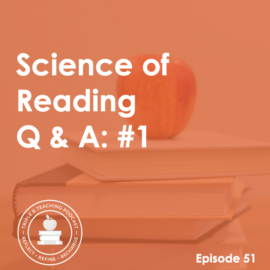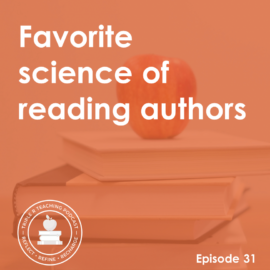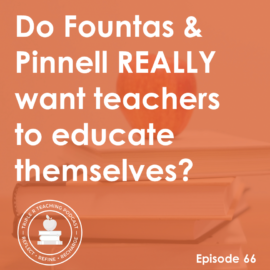
TRT Podcast#60: Reaction to Fountas & Pinnell #4 – Here are the problems with guided reading
For Fountas and Pinnell, guided reading is the key piece of the reading block. But there are some problems with the guided reading approach in K-2.
Listen to the episode here
Full episode transcript
Hello, Anna Geiger here, and I'm excited to join you for Episode 60 of Triple R Teaching. We are continuing our series in which I respond to articles on the Fountas & Pinnell Literacy website. They have published a series called "Just to Clarify," in which they react to criticism of their work.
Today, we're going to look at the blog series' question four, which is "How does guided reading and the use of leveled texts advance the literacy learning of children, and what role does guided reading play within a comprehensive literacy system?"
We're going to start by listening to Irene Fountas' response. We're going to listen to the first portion of it in which she explains what guided reading is:
"Guided reading is small group instruction. Groups are formed with students who are similar at a particular point in time in their reading development. The teacher selects a short text that offers both support and challenge, an instructional level text for their current processing abilities, thus setting the scene for expert differentiated teaching. With explicit teaching, the teacher observes and interacts with students to support more efficient processing. Lessons should take about 15 or 20 minutes per day, perhaps a bit more as the texts get longer. The goal is for students to process one text after another, each with increasing complexity."
She then goes on to explain that guided reading is just one part of the day. You also should be teaching phonemic awareness and phonics and whole class lessons. You should have interactive read-aloud and shared reading, and so on.
So I want to start by saying that I appreciate that here Irene Fountas lets us know that guided reading is just one part of the reading block. However, I want to repeat what I've said before that one problem with balanced literacy, certainly when I was teaching with it, is there tends to be more of a focus on these activities, these structures of, for example, shared reading, guided reading, and so on, rather than a focus on the skills that should be taught within them.
Balanced literacy and guided reading can be haphazard.There may not be a scope and sequence helping teachers understand what they want to teach their students throughout the year. Instead they have a collection of books, and then they choose lessons based on the book rather than starting with the scope and sequence. So that's something to be aware of.
One of the major tenets of guided reading is that children are working with a text at their instructional level. So you assess their level using the Fountas & Pinnell Benchmark Assessment System or running records, and then in the group, you're teaching them with something slightly higher than that called their instructional level.
There has been a lot of discussion and research around teaching kids at a certain level versus giving them access to all different levels of books. I am not going to say that I know a lot about that because I don't. I still need to read and study that a little bit more. I know Timothy Shanahan has written a blog post about it. So I'm not going to address that specifically, but I do want to talk about how Fountas and Pinnell determine reading level.
They use the Fountas and Pinnell Text Level Gradient, which, of course, they created. To determine what level students are at, A through Z, you're going to give them running records or use the running records within their Benchmark Assessment System.
The problem with this, the BIG problem, is that for the youngest readers, the leveling tests - the running records and the assessment system - are really just measuring how good students are at three-cueing because they can't sound out most of the words in those early books. They have to use pictures. They have to use context. They have to use maybe the picture and the first letter.
As we've discussed, especially last week, that's not really reading! That's guessing. Balanced literacy teachers do not want to hear that. Guessing is when you use lots of information, but you don't know for sure if you're right, and that's exactly what this is. If they can't ultimately check that they're right by matching the sounds to the letters, they can't 100% know.
So we have to ask ourselves, "What do these levels really tell us? If a student is at level C or D, what does that mean?"
It can't really tell us a whole lot. It doesn't tell us what phonics knowledge they have. It doesn't tell us how strong they are in phonemic awareness. It can't tell us that because it's impossible to know from a student's reading of one of those early texts. The texts require them to use pictures and context, otherwise there's no way they could read them.
So I have to question the validity of the leveling system, at least for those early levels. I'm not yet ready to say that we should throw out the leveling system or idea for older readers. Maybe I'll get there someday, but I'm not there right now. However, I do have a real problem with it for our youngest readers.
This leads me to my next point. If we have to question the validity of these levels, particularly for our youngest readers in K-2, then we have to question the formation of these groups. Because if we can't really trust or get much value or information out of a level D reading level, then why would we put students who are supposedly level D into a group? They may need quite different instruction.
I believe the better option, particularly for kindergarten and first grade, is to give a strong phonics assessment and then teach phonemic awareness and phonics within those small groups, maybe for about 15 minutes a day.
I know that Fountas and Pinnell will not tell you that phonics is not important. They will tell you it matters. It's important. They have material for teaching phonics. But I have next to me their book about guided reading, their second edition published in 2017, and this is a fat book. We're talking around 600 pages! Would you like to guess at how many pages in this 600-page book address phonics? It's less than five.
Now to be fair, they have other books about phonics. But if you understand the Simple View of Reading and you know that reading comprehension occurs as a result of decoding and language comprehension, you know that we have to give more than five pages of attention to phonics!
In these early guided reading groups, children should be using phonics to solve words because without phonics, there is no decoding.
I'm not ready to say that we should throw guided reading away forever for all grades, but I do question its value with our youngest readers, who really need to work on their foundational skills.
A quick recap of my reaction to Fountas and Pinnell's mini blog post about guided reading. Guided reading lessons are often haphazard, and they don't typically follow a scope and sequence. Another problem is that the levels are not very informative, particularly for our youngest readers. What we really need is to know what phonics knowledge they have. And giving them this A, B, C, D, E, F, G level is really just telling us how good they are at three-cueing because with those early books, they can't sound out most of the words. They don't have the phonics knowledge yet.
Instead, I think time would be better spent, in kindergarten and first grade for sure, giving a strong phonics assessment and grouping students by phonics need and teaching that in the small groups.
Those are some quick thoughts for you on what I think about Fountas and Pinnell's approach to guided reading in the primary grades. Thanks for listening. You can find the show notes at themeasuredmom.com/episode60.
Sign up to receive email updates
Enter your name and email address below and I'll send you periodic updates about the podcast.
Related resources
- Fountas & Pinnell’s series: Just to Clarify
- Emily Hanford’s response: Influential authors Fountas and Pinnell stand behind disproven reading theory
- Mark Seidenberg’s response: Clarity about Fountas and Pinnell
- Timothy Shanahan: Should We Teach Students at Their Reading Levels?
- The difference between balanced and structured literacy







Joe
Interesting read… I have done work at Pinnell house in Columbus… met her one time briefly, nice lady… her house is INSANE!! whatever critiques there are of the scale, they have already broke the bank with the work they have done … so don’t know if either one is really worried about it
Marion
Thank you for your podcastcasts Do you have a scope and sequence for teaching phonics in K one?
Heather Groth, Customer Support
Yes, we do, Marion! You can find it on this post, https://www.themeasuredmom.com/what-order-should-you-teach-phonics-skills/.
Rebecca Stewart
Full disclosure:
I don’t listen to your podcast but I do get your email. I read the transcript for this email.
I get that at lower levels (Kindergarten) the books would have pictures and smart kids would guess and rely too heavily on that. Point understood.
HOWEVER, I heartily believe in a level/range that is a good fit for a child to independently read. Frustration level REALLY exists! Sometimes a child needs to read and reread to get more fluent (you know this, of course).
For the leveled readers I used at the second grade level, we pulled 5-7 per child for the book bag they kept at their desk. Some were on their level, some slightly above and some slightly below. It really worked well!!! Is it the only way? Of course not! I don’t sit and do running records with my own three homeschooled children.
Using leveled readers gave a system in which to manage a classroom. At the second grade level, I didn’t have an issue with pictures in the books giving “too much away.”
That said, I COMPLETELY agree with teaching the phonics lessons and beefing up phonological awareness activities. I have found that at the lower levels (k-1) it’s more beneficial to do lots of word play and manipulation before expecting a child to pick up a book and read.
I’m glad more to see more teachers are using Orton Gillingham based strategies, but taking running records and paying attention to what children were doing in their reading (following trends) has thoroughly paid off for me in the classroom and my tutoring. 🙂
B R
The one question that I have then is how do we assess if a student is reading at grade level? What is grade level reading at different points of the year in K-2?
Keri
Do you have a strong phonics assessment, know of one? I was just in this world of F&P testing today and the test is useless for the low A-C readers.
Anna Geiger
I will actually be creating and sharing one in a couple of weeks!
Josie
I think you are not seeing the whole picture. Guided reading as they say is only “PART” of the reading instructional block. That is about 15-20 minutes of a hopefully 120 minute instructional reading block. The other components being a strong phonics instruction following a scope and sequence, independent reading, whole group instruction where again you follow a scope and sequence of teaching reading skills (which in turn are also taught during those small guided group lessons). As well as spelling and writing components.
Anna Geiger
Hi Josie! Yes, I actually mention this in the podcast. I don’t think guided reading can’t be used, but if we’re using it as Fountas and Pinnell intend it to be used in K-2 – with leveled texts that require kids to use three cueing to read the words – there’s a real problem. Kids need to have reading material that allows them to pratice the phonics knowledge that we’re teaching. Three-cueing is counterproductive at best, damaging at worst.
Susan Dixon
Agreed! K – 2 are critical years for a good phonics foundation.
Thanks, Anna, for sharing this podcast and I am really looking forward to your phonics assessment.
Ini
Agreed.